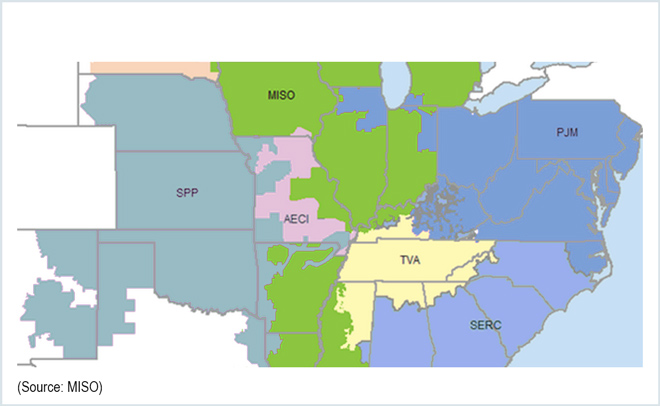By Chris O’Malley
MISO’s Independent Market Monitor says transmission loading relief requests attributed to a Tennessee Valley Authority constraint are causing price volatility within the RTO.
David Patton, CEO of Potomac Economics, told the Markets Committee of the Board of Directors he was concerned MISO is taking costly actions to manage a constraint that is not binding and that TVA may be relying excessively on external relief.
“We have a relatively unfavorable set of provisions that obligate us to model the constraint in our market, as if this is our constraint, and then obligates us to provide what appears to be an oversized amount of relief on the constraint,” Patton said during a presentation to the committee March 25.
Patton cited a TLR event on Feb. 20 in which TVA called for curtailing non-firm commitments toward managing the Volunteer-Phipps Bend constraint. He explained that when a TLR is called, MISO activates the constraint in its market, causing its generators to move and provide the flow relief requested.
The price effects on MISO’s market “can be dramatic,” Patton said, citing the price volatility that occurred in Michigan between 1 a.m. and 1 p.m. on Feb. 20.
Real-time prices at the Michigan Hub that were fluctuating around $50/MWh without the constraint began “bouncing up and down” to as high as $450/MWh with the effect of the constraint. “When prices do this we’re ramping generators up and down,” Patton said.
That one day’s price volatility raised the average price in February by more than 5%, Patton told the committee.
Uneconomic Flows
Besides causing price volatility, the TLRs affect the dispatch of MISO’s resources, Patton said, pointing to flows between MISO South and MISO Midwest regions.
Without the TLR constraint, transfers from MISO South to MISO Midwest were economic because of relatively high natural gas prices in the Midwest.
But the February constraint caused flows to frequently change direction and flow uneconomically from Midwest to South, Patton said.

“One is that the amount of relief we’re being asked for is overly aggressive,” Patton continued, and the other is that MISO’s flows aren’t considered firm even though it is dispatching its own generation to serve its load.
“We also have concerns about other entities around us that are being overly aggressive in their use of the TLR process and we’re not sure there’s any oversight of what entities are doing.”
Board Chairman Judy Walsh asked Patton what MISO can do about the problem and how much it is costing the RTO.
Patton said he believes there are provisions that would allow MISO to categorize its day-ahead dispatch as firm. That would allow the RTO not to have to provide relief unless entities around MISO, including TVA, are curtailing services or redispatching their own systems. “At this point we’re carrying all the water on a day like this.”
As for cost, “it’s costing us tens of millions [of dollars] in congestion. It’s hard to quantify what it costs us” insofar as ramping generation up and down.
On the upside, Patton said the biggest concerns MISO has had historically with TLRs involved SPP, but the market-to-market process the RTOs now use to cooperatively manage each other’s constraints has virtually eliminated those TLRs.
Working on Congestion Management
Todd Ramey, who manages MISO’s real-time operations, told the committee that the TVA constraints are “interregional transfer constraints that bind infrequently but predictably.”
Typically this occurs when there are high loads to the north and east of the interconnection and lower and more moderate loads to the south and west.
The weather was particularly cold in the north on the day cited by Patton.
Ramey said he has no doubts that reliability concerns of the TVA reliability coordinator in the flow gate “were legitimate” during the period in February, but he said he concurred with Patton’s concerns.
Since the Feb. 20 constraint, MISO has been working with TVA to improve joint administration, Ramey said. “Efforts are underway. We’ve had conference calls with TVA” and plan additional meetings to go over data for joint congestion management, Ramey added.
Winter Performance Improved
At the meeting, Patton also summarized market conditions for February and noted a stark contrast from a year earlier, when the RTO struggled with extreme cold during the polar vortex.
This February, energy prices were down almost 40% — and natural gas prices down 57% compared to the year before.
“Market conditions were quite a bit more stable this year,” Patton said, noting fewer fuel supply issues, more available generating units and milder weather.
Ramey said while this past winter has been referred to as relatively mild, there were some parts of the MISO region that experienced cold temperatures reminiscent of the winter of 2013-14. Ramey cited a much-improved performance of peaking units and continued coordination with gas pipeline operators in the most recent winter.



